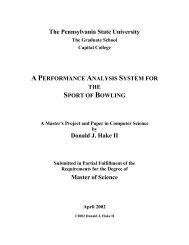k-Nearest Neighbor Classification on Spatial Data Streams Using P ...
k-Nearest Neighbor Classification on Spatial Data Streams Using P ...
k-Nearest Neighbor Classification on Spatial Data Streams Using P ...
You also want an ePaper? Increase the reach of your titles
YUMPU automatically turns print PDFs into web optimized ePapers that Google loves.
the corresp<strong>on</strong>ding nodes in the two operand PM-trees level-by-level starting from the<br />
root node. A pure0 node ANDed with any node produces a pure0 node. A pure1 node<br />
ANDed with any node, n, produces the node n; we just need to copy the node, n, to<br />
the resultant PM-tree in the corresp<strong>on</strong>ding positi<strong>on</strong>. ANDing of two mixed nodes<br />
produces a mixed node; the children of the resultant mixed node are obtained by<br />
ANDing children of the operands recursively. The details of P-tree operati<strong>on</strong>s can be<br />
found in [10, 11].<br />
P-tree-1: m<br />
____/ / \ \____<br />
/ / \ \<br />
/ / \ \<br />
1 m m 1<br />
/ / \ \ / / \ \<br />
m 0 1 m 1 1 m 1<br />
//|\ //|\ //|\<br />
1110 0010 1101<br />
P-tree-2: m<br />
____/ / \ \____<br />
/ / \ \<br />
/ / \ \<br />
1 0 m 0<br />
/ / \ \<br />
1 1 1 m<br />
//|\<br />
0100<br />
AND: m<br />
___ / / \ \___<br />
/ ___ / \ \<br />
/ / \ \<br />
1 0 m 0<br />
/ | \ \<br />
1 1 m m<br />
//|\ //|\<br />
1101 0100<br />
OR: m<br />
___ / / \ \__<br />
/ __ / \ \<br />
/ / \ \<br />
1 m 1 1<br />
/ / \ \<br />
m 0 1 m<br />
//|\ //|\<br />
1110 0010<br />
Fig. 2. P-tree Algebra<br />
3. The <str<strong>on</strong>g>Classificati<strong>on</strong></str<strong>on</strong>g> Algorithms<br />
In the original k-nearest neighbor (KNN) classificati<strong>on</strong> method, no classifier model is<br />
built in advance. KNN refers back to the raw training data in the classificati<strong>on</strong> of each<br />
new sample. Therefore, <strong>on</strong>e can say that the entire training set is the classifier. The<br />
basic idea is that the similar tuples most likely bel<strong>on</strong>gs to the same class (a c<strong>on</strong>tinuity<br />
assumpti<strong>on</strong>). Based <strong>on</strong> some pre-selected distance metric (some comm<strong>on</strong>ly used<br />
distance metrics are discussed in introducti<strong>on</strong>), it finds the k most similar or nearest<br />
training samples of the sample to be classified and assign the plurality class of those k<br />
samples to the new sample [4, 7]. The value for k is pre-selected. <strong>Using</strong> relatively<br />
larger k may include some not so similar pixels and <strong>on</strong> the other hand, using very<br />
smaller k may exclude some potential candidate pixels. In both cases the classificati<strong>on</strong><br />
accuracy will decrease. The optimal value of k depends <strong>on</strong> the size and nature of the<br />
data. The typical value for k is 3, 5 or 7. The steps of the classificati<strong>on</strong> process are:<br />
1) Determine a suitable distance metric.<br />
2) Find the k nearest neighbors using the selected distance metric.<br />
3) Find the plurality class of the k-nearest neighbors (voting <strong>on</strong> the class<br />
labels of the NNs).<br />
4) Assign that class to the sample to be classified.<br />
We provided two different algorithms using P-trees, based two different distance<br />
metrics max (Minkowski distance with q = ∞) and our newly defined HOB distance.<br />
Instead of examining individual pixels to find the nearest neighbors, we start our<br />
initial neighborhood (neighborhood is a set of neighbors of the target pixel within a<br />
specified distance based <strong>on</strong> some distance metric, not the spatial neighbors, neighbors<br />
with respect to values) with the target sample and then successively expand the
















